Photography in the ‘Jungle’
This guest blog is written by Rob Pinney, one of the photographers who submitted photos for our exhibition, Call Me By My Name: Stories from Calais and Beyond, which is at 28 Redchurch Road, London, until 22 June (details here). Rob’s book, The Jungle, is on sale at the exhibition and from his website (see below) with all profits going to charities working in Calais.
A complex relationship in a complex place
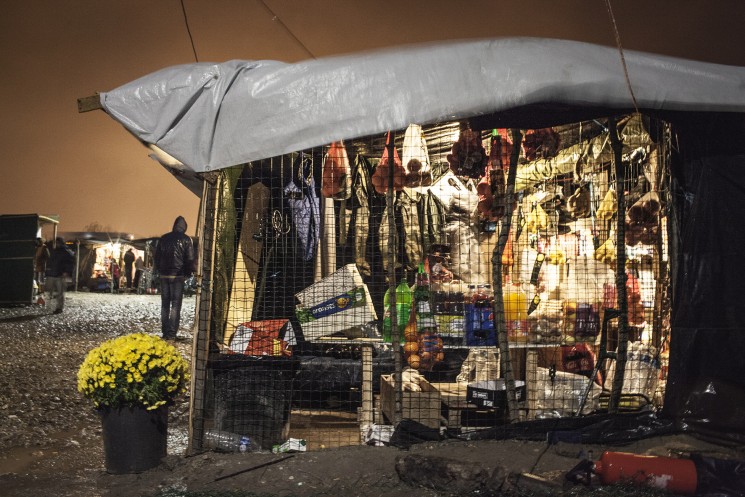
Grocery Store, November 2015. Shops like this provide, among other things, basic food staples and mobile phone credit top-ups, incredibly important for keeping in touch with family both at home and often at different stages of the refugee ‘trail’ through Europe. Many people in the ‘Jungle’ report having been victimised and attacked by both the police and ordinary citizens when outside the camp, and so feel unsafe walking into Calais to use local shops. This particular shop was destroyed in March 2016 as part of the eviction and demolition of the southern half of the camp. © Rob Pinney
As the main point of departure for sea and rail travel to Britain, the coastal town of Calais in northern France has become a ‘hotspot’ for asylum seekers hoping to build a new life in the United Kingdom.
‘The Jungle’ — the term used to refer to the shanty town settlements that have become synonymous with Calais — has no fixed location. But it is most commonly associated with a former landfill site not far from the ferry port that at its peak during the 2015 refugee crisis held a population of some 8,000 people.
The political discourse around the jungle and those temporarily seeking shelter there thrives on generalisations. Labelled a ‘swarm’ and a ‘bunch of migrants’ by British Prime Minister David Cameron, in the eyes of many the people here are not individuals but a collective mass — the object of a confused war of words: ‘refugees’, ‘asylum seekers’, ‘economic migrants’.
The reality is far more complicated. Many have fled war and political persecution. Others, notably from Afghanistan and Iran, left to avoid being made to fight for a cause they did not believe in. Many will show you photographs on their mobile phones of family already living in the United Kingdom, whom they hope to join. And some have spent years, occasionally decades, living and working in the UK, only to find themselves suddenly ejected. For them, the journey is not one of migration but a return home.
‘What is it like?’, often asked, is a simple question that defies an equally straightforward answer. Unlike the epic photographs of Zaatari in Jordan, whose orderly lines of identical shelters extend outwards on a vast scale, the Jungle follows no such logic. The Jungle is a city. Alongside countless tents and shelters, nestled into any and all available space with little regard to order, stand shops, cafes, restaurants, hairdressers. While different nationalities have generally grouped themselves together — as is common in any city — these lines are also frequently transgressed by a shared political precarity that unites its citizens. But above all, the Jungle is a city that is constantly changing. Some of these changes are internal and organic, but others have been the result of more profound changes in the political landscape in which the Jungle is deeply embedded, and yet over which it holds no control.
While cameras are a common sight, they are treated with great suspicion. Many people are wary of being photographed: some fear it may endanger their families should news of their escape reach home; others worry that evidence of their presence in France may be used against them should they eventually claim asylum in Britain; and others still feel ashamed of the situation they now find themselves in and do not want it immortalised in any resulting pictures.
It is not difficult to create photographs that evoke misery and suffering in the Jungle. And while such pictures might fit with what we think documentary photography ought to look like, such images usually take recourse to particular visual tropes and do little to deepen public understanding of a complex place at a time when greater understanding is so sorely needed. At the same time, it would be wrong to beautify what remains an utterly deplorable situation that exists not out of necessity but because of broken politics.
The photographs presented here are drawn from a much larger collection that spans four trips over six months. This selection is tempered by conversations I have had with some of those who live there about photography and the representation of the Jungle in the media. One friend from Darfur lamented the way in which many photographers came simply to ‘make their own business’. While I hope that the time I have spent volunteering on each of these trips is sufficient in his eyes to keep me out of this category, I also hope that the images here are seen as ones that are sensitive and respectful towards the issues so frequently voiced by the Jungle’s people. There are no portraits, nor any identifiable faces. In their place, I have tried to show traces of the many lives that are now collectively on hold. The impression left may be one of a desolate, depopulated landscape. But the reality couldn’t be further from that: beyond the edges of each frame is a vibrant and dynamic city in the making.
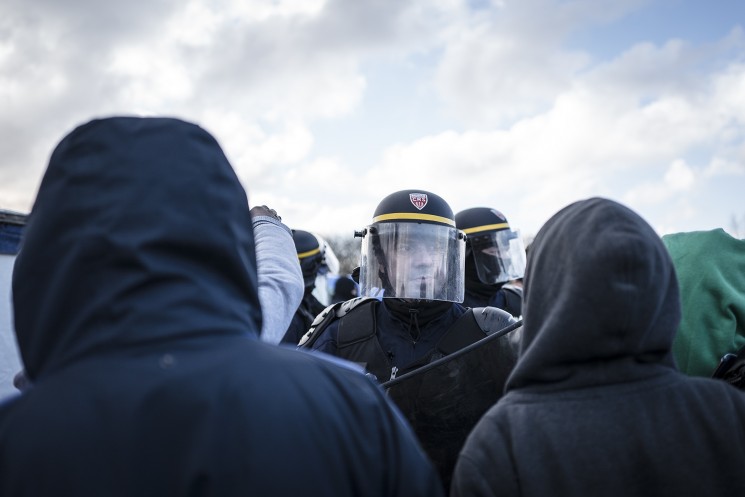
Police Lines, March 2016. Eritrean men watch through police lines as their shelters are destroyed. Following the partial eviction that took place in January 2016, the authorities announced a more significant intervention two months later: the southern half of the camp was to be evicted and demolished. They estimated that this area contained 800–1,000 people, but a census conducted by charities working in the camp suggested the figure was as high as 3,500. Many of those who lost their homes chose to leave the ‘Jungle’ and retrace their steps, often heading back to Germany, where asylum policy is thought to be more lenient. But many others moved into the little remaining space in the northern half of the camp, condensing those from different communities ever closer together. © Rob Pinney
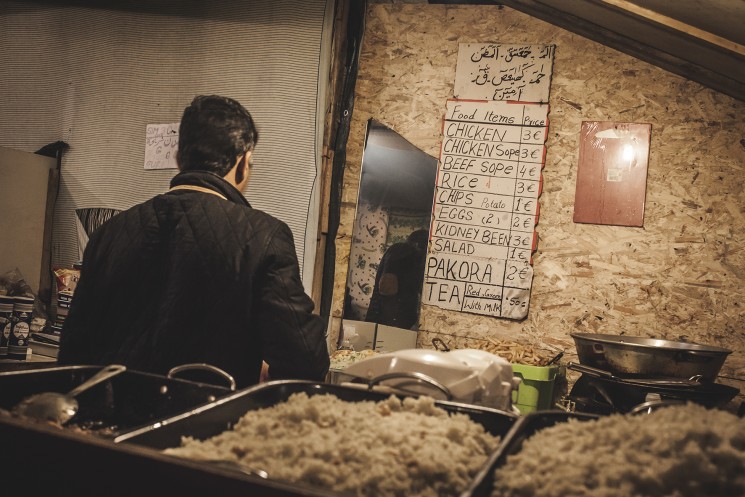
Mario’s, November 2015. Mario’s is one of a number of restaurants that used to line the mud road running through the southern half of the camp. Many of the owners were formerly child asylum seekers who had been granted leave to remain in the United Kingdom but who had to leave upon turning 18 years old. Many now have asylum in France and, in some cases, Italy, but continue to run their businesses in the ‘Jungle’. Mario, who owned the 3 Star Hotel, was given his name on account of his impressive moustache. The hotel was among the hundreds of makeshift restaurants, businesses and homes that were destroyed as part of the eviction and demolition of the southern half of the camp in March 2016. Since then, and as the number of newcomers has started to increase once more, many of the remaining restaurants have opened their doors to people hoping to avoid the bitter cold of a night spent in a tent. © Rob Pinney
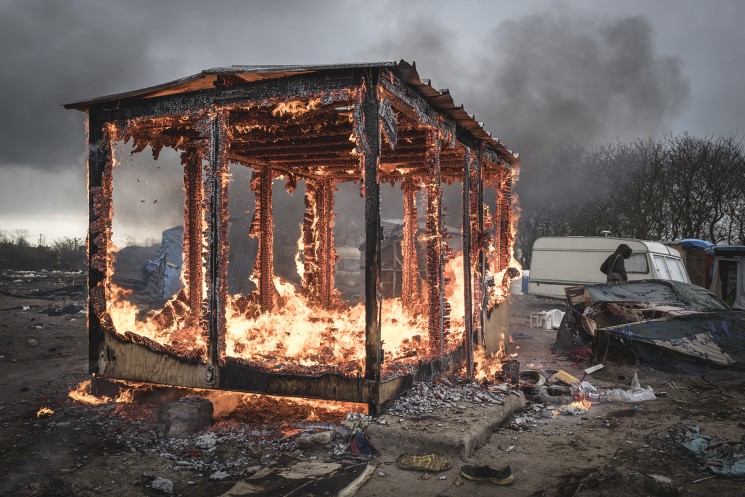
Burning Shelter, March 2016. As the eviction of the southern half of the ‘Jungle’ gathered pace, fires set by refugees and the use of tear gas by French riot police became commonplace. In the UK, the media have woven the persistence of fires into a narrative of destruction and lawlessness. But you might also see it this way: the decision to put a match to the walls of their shelters is arguably the only way refugees were able to exert at least a degree of agency over the inevitable destruction of their homes. © Rob Pinney
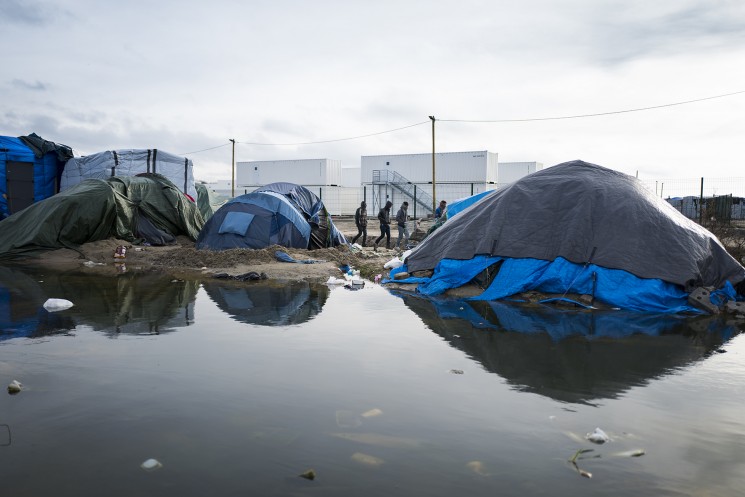
Shipping Container, January 2016. In January 2016, French authorities announced that they were going to clear a 100-metre ‘buffer zone’ between the edge of the camp and the adjacent motorway, which leads to the ferry port. At the time, charities working on the ground estimated that this would mean the displacement of more than 1,000 people. It was suggested that at least some of the displaced could move into these newly built converted shipping containers. Among residents of the ‘Jungle’, the reaction to the new containers – presented generally in the British media as a generous gesture – was decidedly mixed. Although they offered a warm and dry place to sleep for 1,500 people, the fear was that the registration information and biometric data that were gathered as the condition of a place (entry is granted by a handprint scanner) might be used against any refugee reaching Britain and making an eventual asylum claim under the Dublin Regulation. More generally, many also felt that by moving into the new containers they would isolate themselves from family, friends and the broader social environment of the camp. One resident described the containers as being ‘like a prison camp’. © Rob Pinney
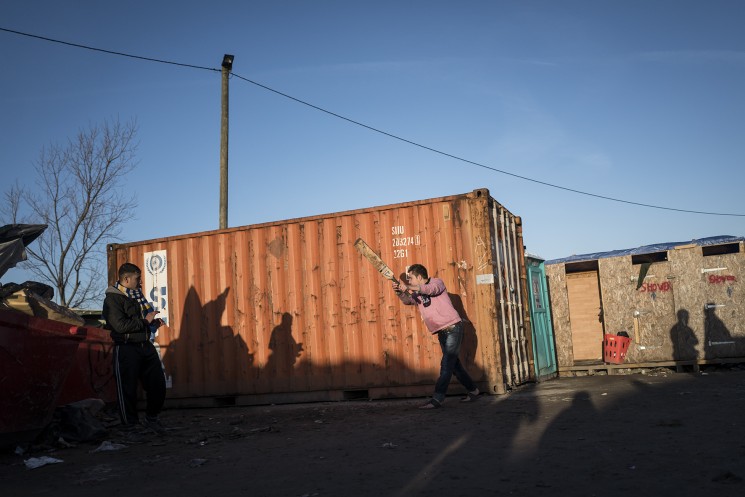
Cricket in Afghan Square, January 2016. Although still bitterly cold, this was the first full day of sunshine after several weeks of rain, during what was for many refugees their first experience of a northern European winter. Under these conditions, once clothes become wet, they are almost impossible to dry out again – so many refugees made full use of this momentary shift in the weather to get out and play. The shipping container in the background houses a small fire engine, built and funded by volunteers from the United Kingdom and operated by a small crew of trained refugees. © Rob Pinney
Rob Pinney is a documentary photographer and researcher with a particular interest in war, post-conflict, displacement and migration issues. His project in Calais is ongoing, a portion of which is now available as a book, The Jungle, available at Call Me By My Name. To see the full series, visit his website. His Twitter handle is @robpinney and his Instagram account is @rob.pinney.


Leave a Reply